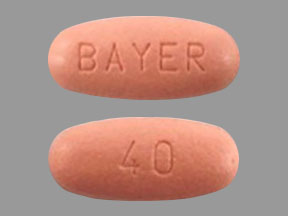Regorafenib Dosage
Medically reviewed by Drugs.com. Last updated on Mar 3, 2025.
Applies to the following strengths: 40 mg
Usual Adult Dose for:
Additional dosage information:
Usual Adult Dose for Colorectal Cancer
160 mg orally once a day for the first 21 days of each 28-day cycle until disease progression or unacceptable toxicity
Uses:
- Metastatic colorectal cancer (CRC) previously treated with fluoropyrimidine-, oxaliplatin-, and irinotecan-based chemotherapy, an anti-VEGF therapy, and an anti-EGFR therapy if RAS wild-type
- Locally advanced, unresectable or metastatic GI stromal tumor (GIST) previously treated with imatinib mesylate and sunitinib malate
- Hepatocellular carcinoma (HCC) previously treated with sorafenib
Usual Adult Dose for Gastrointestinal Stromal Tumor
160 mg orally once a day for the first 21 days of each 28-day cycle until disease progression or unacceptable toxicity
Uses:
- Metastatic colorectal cancer (CRC) previously treated with fluoropyrimidine-, oxaliplatin-, and irinotecan-based chemotherapy, an anti-VEGF therapy, and an anti-EGFR therapy if RAS wild-type
- Locally advanced, unresectable or metastatic GI stromal tumor (GIST) previously treated with imatinib mesylate and sunitinib malate
- Hepatocellular carcinoma (HCC) previously treated with sorafenib
Usual Adult Dose for Hepatocellular Carcinoma
160 mg orally once a day for the first 21 days of each 28-day cycle until disease progression or unacceptable toxicity
Uses:
- Metastatic colorectal cancer (CRC) previously treated with fluoropyrimidine-, oxaliplatin-, and irinotecan-based chemotherapy, an anti-VEGF therapy, and an anti-EGFR therapy if RAS wild-type
- Locally advanced, unresectable or metastatic GI stromal tumor (GIST) previously treated with imatinib mesylate and sunitinib malate
- Hepatocellular carcinoma (HCC) previously treated with sorafenib
Renal Dose Adjustments
No adjustment recommended.
Liver Dose Adjustments
Mild (Child-Pugh A) hepatic impairment: No adjustment recommended.
Moderate (Child-Pugh B) hepatic impairment: Dose adjustment(s) may be required; however, no specific guidelines have been suggested. Caution recommended.
Severe (Child-Pugh C) hepatic impairment: Not recommended.
DOSE MODIFICATIONS FOR HEPATIC IMPAIRMENT:
ALT AND/OR AST:
GREATER than or equal to 5 times upper limit of normal (ULN) (maximum Grade 2):
- Any occurrence: Continue therapy; monitor liver function weekly until transaminases return to less than 3 x ULN (Grade 1) or baseline
- First occurrence: Interrupt therapy; monitor transaminases weekly until return to less than 3 times ULN or baseline.
- Restart: If the potential benefit outweighs the risk of hepatotoxicity, restart therapy, reduce dose by 40 mg, and monitor liver function weekly for at least 4 weeks
- Reoccurrence: Permanently discontinue therapy.
- Any occurrence: Permanently discontinue therapy.
- Any occurrence: Permanently discontinue therapy; Monitor liver function weekly until resolution or return to baseline.
- Exception: Patients with Gilbert's syndrome who develop elevated transaminases should be managed as per the above outlined recommendations for the respective observed elevation of ALT and/or AST.
Dose Adjustments
If dose modifications are required, reduce the dose in 40 mg increments; the lowest recommended daily dose is 80 mg daily.
INTERRUPT DOSING FOR:
- Grade 2 hand-foot skin reaction (HFSR; palmar-plantar erythrodysesthesia syndrome) that is recurrent or does not improve within 7 days despite dose reduction; interrupt dosing for at least 7 days for Grade 3 HFSR.
- Symptomatic Grade 2 hypertension
- Any Grade 3 or 4 adverse reaction
- Worsening infection of any Grade
REDUCE DOSE to 120 mg for:
- First occurrence of Grade 2 HFSR of any duration
- After recovery of any Grade 3 or 4 adverse reaction (except infection)
REDUCE DOSE to 80 mg for:
- Recurrence of Grade 2 HFSR at the 120 mg dose
- After recovery of any Grade 3 or 4 adverse reaction at the 120 mg dose (except hepatotoxicity or infection)
PERMANENTLY DISCONTINUE THERAPY for:
- Failure to tolerate 80 mg dose
- Any Grade 4 adverse reaction; only resume therapy if the potential benefit outweighs the risks
Precautions
US BOXED WARNINGS:
HEPATOTOXICITY:
- Severe, sometimes fatal, hepatotoxicity has been reported.
- Monitor hepatic function prior to and during therapy.
- Interrupt and then reduce the dose or discontinue this drug for hepatotoxicity as manifested by elevated liver function tests or hepatocellular necrosis, depending upon severity and persistence.
CONTRAINDICATIONS:
- None
Safety and efficacy have not been established in patients younger than 18 years.
Consult WARNINGS section for additional precautions.
Dialysis
Data not available
Other Comments
Administration advice:
- Take this drug at the same time each day.
- Swallow tablet whole with water after a low-fat meal that contains less than 600 calories and less than 30% fat.
- Do not take 2 doses of this drug on the same day to make up for a missed dose from the previous day.
Storage requirements:
- Store at 25C (77F); excursions are permitted from 15C to 30C (59F to 86).
- To protect from moisture, keep tablets in the original bottle and do not remove the desiccant.
- Keep the bottle tightly closed after opening; discard any unused tablets 7 weeks after opening the bottle.
Reconstitution/preparation techniques:
- The manufacturer product information should be consulted.
General:
- Overdose: There is no known antidote; in the event of suspected overdose: immediately interrupt dosing, institute supportive care, and observe until clinical stabilization.
Monitoring:
- Cardiovascular: Blood pressure (weekly for the first 6 weeks of therapy and then every cycle or more frequently, as clinically indicated)
- Hepatic: ALT, AST, bilirubin (at least every 2 weeks during the first 2 months of therapy; thereafter, monitor monthly or more frequently as clinically indicated)
- Metabolism: Biochemical and metabolic parameters (periodically during treatment)
Patient advice:
- Avoid drinking grapefruit juice and taking St. John's Wort during treatment.
- Take this drug after eating a low-fat meal that contains less than 30% fat and less than 600 calories. An example: 1 cup of cereal (about 30 g), 1 glass (about 250 mL) of skim milk, 1 slice of toast with jam, 1 glass of apple juice, and 1 cup of coffee or tea (2 g fat, 520 calories).
More about regorafenib
- Check interactions
- Compare alternatives
- Reviews (14)
- Side effects
- During pregnancy
- Drug class: multikinase inhibitors
- Breastfeeding
- En español
Patient resources
Other brands
Professional resources
Other brands
Related treatment guides
See also:
Further information
Always consult your healthcare provider to ensure the information displayed on this page applies to your personal circumstances.


